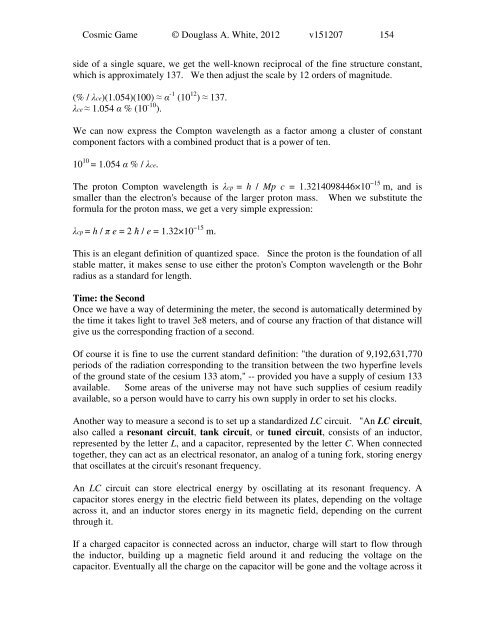You also want an ePaper? Increase the reach of your titles
YUMPU automatically turns print PDFs into web optimized ePapers that Google loves.
<strong>Cosmic</strong> <strong>Game</strong> © Douglass A. White, 2012 v151207 154<br />
side of a single square, we get the well-known reciprocal of the fine structure constant,<br />
which is approximately 137. We then adjust the scale by 12 orders of magnitude.<br />
(% / λce)(1.054)(100) ≈ α -1 (10 12 ) ≈ 137.<br />
λce ≈ 1.054 α % (10 -10 ).<br />
We can now express the Compton wavelength as a factor among a cluster of constant<br />
<strong>com</strong>ponent factors with a <strong>com</strong>bined product that is a power of ten.<br />
10 10 = 1.054 α % / λce.<br />
<strong>The</strong> proton Compton wavelength is λcp = h / Mp c = 1.3214098446×10 −15 m, and is<br />
smaller than the electron's because of the larger proton mass. When we substitute the<br />
formula for the proton mass, we get a very simple expression:<br />
λcp = h / π e = 2 ħ / e = 1.32×10 −15 m.<br />
This is an elegant definition of quantized space. Since the proton is the foundation of all<br />
stable matter, it makes sense to use either the proton's Compton wavelength or the Bohr<br />
radius as a standard for length.<br />
Time: the Second<br />
Once we have a way of determining the meter, the second is automatically determined by<br />
the time it takes light to travel 3e8 meters, and of course any fraction of that distance will<br />
give us the corresponding fraction of a second.<br />
Of course it is fine to use the current standard definition: "the duration of 9,192,631,770<br />
periods of the radiation corresponding to the transition between the two hyperfine levels<br />
of the ground state of the cesium 133 atom," -- provided you have a supply of cesium 133<br />
available. Some areas of the universe may not have such supplies of cesium readily<br />
available, so a person would have to carry his own supply in order to set his clocks.<br />
Another way to measure a second is to set up a standardized LC circuit. "An LC circuit,<br />
also called a resonant circuit, tank circuit, or tuned circuit, consists of an inductor,<br />
represented by the letter L, and a capacitor, represented by the letter C. When connected<br />
together, they can act as an electrical resonator, an analog of a tuning fork, storing energy<br />
that oscillates at the circuit's resonant frequency.<br />
An LC circuit can store electrical energy by oscillating at its resonant frequency. A<br />
capacitor stores energy in the electric field between its plates, depending on the voltage<br />
across it, and an inductor stores energy in its magnetic field, depending on the current<br />
through it.<br />
If a charged capacitor is connected across an inductor, charge will start to flow through<br />
the inductor, building up a magnetic field around it and reducing the voltage on the<br />
capacitor. Eventually all the charge on the capacitor will be gone and the voltage across it





